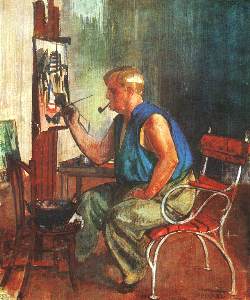Vilmos Aba-Novák
- View a machine-translated version of the Hungarian article.
- Machine translation, like DeepL or Google Translate, is a useful starting point for translations, but translators must revise errors as necessary and confirm that the translation is accurate, rather than simply copy-pasting machine-translated text into the English Wikipedia.
- Do not translate text that appears unreliable or low-quality. If possible, verify the text with references provided in the foreign-language article.
- You must provide copyright attribution in the edit summary accompanying your translation by providing an interlanguage link to the source of your translation. A model attribution edit summary is
Content in this edit is translated from the existing Hungarian Wikipedia article at [[:hu:Aba-Novák Vilmos]]; see its history for attribution. - You may also add the template
{{Translated|hu|Aba-Novák Vilmos}}to the talk page. - For more guidance, see Wikipedia:Translation.

Vilmos Aba-Novák (Hungarian: Aba-Novák Vilmos, until 1912: Hungarian: Novák Vilmos; March 15, 1894 – September 29, 1941[1]) was a Hungarian painter and graphic artist. He was an original representative of modern art in his country, and specifically of its modern monumental painting. He was also the celebrated author of frescoes and church murals at Szeged and Budapest,[2] and was officially patronized by the Hungarian nobility.
Biography

Novák was born in Budapest, Hungary, where he would also die. His father was Gyula Novák, and the mother was Rosa Waginger (Hungarian: Waginger Róza) from Vienna.
After studying at the Art School until 1912, he began work under Adolf Fényes. Between 1912 and 1914, Novák studied at the College of Fine Arts in Budapest.[1] Completing his service in the Austro-Hungarian Army on the Eastern Front during World War I, he took up drawing with Viktor Olgyai.
Between 1921 and 1923, he spent his summers with the group of artists in Szolnok[1] and Baia Mare (Nagybánya), Romania (see Baia Mare School), and was first exhibited in 1924. He was sent by the Hungarian Academy as a Fellow on a scholarship to Rome (1928 and 1930).
Aba Novák painted many frescoes for the Roman Catholic Church of Jászszentandrás, and Hősök Kapuja (Heroes' Gate - a rare Hungarian example of novecento architecture, commemorating World War I soldiers) in Szeged in 1936 (the latter was white-washed after 1945, restored between 1986 and 2000), and painted many commissions for the Hungarian government.[1] Aba also worked on frescoes of the St. Stephen's Mausoleum in Székesfehérvár and on the Church in Városmajor, Budapest, in 1938. The jury's Grand Prize at the Paris World Exhibition in 1937 and the 1940 Venice Biennale were both awarded to him.[1]
He was a teacher at the College of Fine Arts from 1939[1] until his death.
References
- ^ a b c d e f "Aba Novák, Vilmos." Encyclopædia Britannica. 21 January 2007.
- ^ Chambers Biographical Dictionary, ISBN 0-550-18022-2, page 1
External links
- Works at Wikiart
- Works at Artnet
- Robert Edwards, Vilmos Aba Novák

- v
- t
- e











